Skill Validation of High-Impact Rainfall Forecasts over Vietnam Using the European Centre for Medium-Range Weather Forecasts (ECMWF) Integrated Forecasting System (IFS) and Dynamical Downscaling with the Weather Research and Forecasting Model
Abstract
1. Introduction
2. Model Descriptions
2.1. The European Centre for Medium-Range Weather Forecasts High-Resolution Integrated Forecasting System (ECMWF IFS) Model
2.2. The Weather Research and Forecasting Model with the Advanced Research WRF Core (WRF-ARW) Model
3. Observational Data and Verification Methodology
3.1. Vietnam Sub-Climate Regions and Precipitation Observational Data
3.2. Validation Methods
4. Results and Discussion
4.1. General Skill Statistics
4.1.1. For the Forecast Range of 24 h
4.1.2. For Longer Forecast Ranges of 48 h and 72 h
4.2. Yearly Performances
4.3. Spatial Distributions for Skill Scores of Intense Rain Events
4.4. Extreme Heavy Rainfall Forecast Skills
5. Conclusions
Author Contributions
Funding
Institutional Review Board Statement
Informed Consent Statement
Data Availability Statement
Acknowledgments
Conflicts of Interest
References
- Yokoi, S.; Matsumoto, J. Collaborative effects of cold surge and tropical depression–type disturbance on heavy rainfall in central Vietnam. Mon. Weather Rev. 2008, 136, 3275–3287. [Google Scholar] [CrossRef]
- Van der Linden, R.; Fink, A.H.; Pinto, J.G.; Phan-Van, T. The dynamics of an extreme precipitation event in northeastern Vietnam in 2015 and its predictability in the ECMWF ensemble prediction system. Weather Forecast. 2017, 32, 1041–1056. [Google Scholar] [CrossRef]
- Ngo-Duc, T.; Kieu, C.; Thatcher, M.; Nguyen-Le, D.; Phan-Van, T. Climate projections for Vietnam based on regional climate models. Clim. Res. 2014, 60, 199–213. [Google Scholar] [CrossRef]
- Phan, V.T.; Ngo-Duc, T. Seasonal and interannual variations of surface climate elements over Vietnam. Clim. Res. 2009, 40, 49–60. [Google Scholar] [CrossRef]
- Simmons, A.J.; Hollingsworth, A. Some aspects of the improvement in skill of numerical weather prediction. Q. J. R. Meteorol. Soc. A J. Atmos. Sci. Appl. Meteorol. Phys. Oceanogr. 2002, 128, 647–677. [Google Scholar] [CrossRef]
- Vogel, P.; Knippertz, P.; Fink, A.H.; Schlueter, A.; Gneiting, T. Skill of global raw and postprocessed ensemble predictions of rainfall in the tropics. Weather Forecast. 2020, 35, 2367–2385. [Google Scholar] [CrossRef]
- Hamill, T.M. Verification of TIGGE multimodel and ECMWF reforecast-calibrated probabilistic precipitation forecasts over the contiguous United States. Mon. Weather Rev. 2012, 140, 2232–2252. [Google Scholar] [CrossRef]
- Bauer, H.S.; Schwitalla, T.; Wulfmeyer, V.; Bakhshaii, A.; Ehret, U.; Neuper, M.; Caumont, O. Quantitative precipitation estimation based on high-resolution numerical weather prediction and data assimilation with WRF—A performance test. Tellus A Dyn. Meteorol. Oceanogr. 2015, 67, 25047. [Google Scholar] [CrossRef]
- Hung, M.K.; Tien, D.D.; Quan, D.D.; Duc, T.A.; Dung, P.T.P.; Hole, L.R.; Nam, H.G. Assessments of use of blended radar–numerical weather prediction product in short-range warning of intense rainstorms in localized systems (SWIRLS) for quantitative precipitation forecast of tropical cyclone landfall on Vietnam’s Coast. Atmosphere 2023, 14, 1201. [Google Scholar] [CrossRef]
- Haiden, T.; Rodwell, M.J.; Richardson, D.S.; Okagaki, A.; Robinson, T.; Hewson, T. Intercomparison of global model precipitation forecast skill in 2010/11 using the SEEPS score. Mon. Weather Rev. 2012, 140, 2720–2733. [Google Scholar] [CrossRef]
- World Meteorological Organization. Guidelines on High-resolution Numerical Weather Prediction (WMO-No. 1311). Available online: https://library.wmo.int/idurl/4/66217 (accessed on 15 January 2025).
- Furnari, L.; Magnusson, L.; Mendicino, G.; Senatore, A. Fully coupled high-resolution medium-range forecasts: Evaluation of the hydrometeorological impact in an ensemble framework. Hydrol. Process. 2022, 36, e14503. [Google Scholar] [CrossRef]
- Su, D.; Zhong, J.; Xu, Y.; Lv, L.; Liu, H.; Fan, X.; Han, L.; Wang, F. SAL Method Applied in Grid Forecasting Product Verification with Three-Source Fusion Product. Atmosphere 2024, 15, 1366. [Google Scholar] [CrossRef]
- Magnusson, L.; Ackerley, D.; Bouteloup, Y.; Chen, J.H.; Doyle, J.; Earnshaw, P.; Kwon, Y.C.; Köhler, M.; Lang, S.K.; Lim, Y.J.; et al. Skill of medium-range forecast models using the same initial conditions. Bull. Am. Meteorol. Soc. 2022, 103, E2050–E2068. [Google Scholar] [CrossRef]
- Skamarock, W.C.; Klemp, J.B.; Dudhia, J.; Gill, D.O.; Barker, D.M.; Duda, M.G.; Huang, X.Y.; Wang, W.; Powers, J.G. A description of the advanced research WRF version 3. NCAR Tech. Note 2008, 475, 10–5065. [Google Scholar] [CrossRef]
- Parrish, D.F.; Derber, J.C. The National Meteorological Center’s spectral statistical-interpolation analysis system. Mon. Weather Rev. 1992, 120, 1747–1763. [Google Scholar] [CrossRef]
- Roversi, G.; Pancaldi, M.; Cossich, W.; Corradini, D.; Nguyen, T.T.N.; Nguyen, T.V.; Porcu, F. The extreme rainfall events of the 2020 typhoon season in Vietnam as seen by seven different precipitation products. Remote Sens. 2024, 16, 805. [Google Scholar] [CrossRef]
- Wilks, D.S. Statistical Methods in the Atmospheric Sciences; Academic Press: Cambridge, MA, USA, 2011. [Google Scholar]
- World Meteorological Organization. Guide to Instruments and Methods of Observation; World Meteorological Organization: Geneva, Switzerland, 2018; p. 548. [Google Scholar]
- Lavers, D.A.; Harrigan, S.; Prudhomme, C. Precipitation biases in the ECMWF integrated forecasting system. J. Hydrometeorol. 2021, 22, 1187–1198. [Google Scholar] [CrossRef]
- Chen, Y.; Huang, G.; Wang, Y.; Tao, W.; Tian, Q.; Yang, K.; Zheng, J.; He, H. Improving the heavy rainfall forecasting using a weighted deep learning model. Front. Environ. Sci. 2023, 11, 1116672. [Google Scholar] [CrossRef]
- Lang, S.; Rodwell, M.; Schepers, D. IFS upgrade brings many improvements and unifies medium-range resolutions. ECMWF Newsl. 2023, 176, 21–28. [Google Scholar] [CrossRef]
- Skok, G.; Roberts, N. Analysis of fractions skill score properties for random precipitation fields and ECMWF forecasts. Q. J. R. Meteorol. Soc. 2016, 142, 2599–2610. [Google Scholar] [CrossRef]
- Ebert, E.E.; Gallus, W.A., Jr. Toward better understanding of the contiguous rain area (CRA) method for spatial forecast verification. Weather Forecast. 2009, 24, 1401–1415. [Google Scholar] [CrossRef]
- Ding, C.; Su, Z.; Ren, F.; Wong, W.K.; Chen, B.; Ren, H. Prediction of tropical cyclone precipitation over China by the DSAEF_LTP model. Q. J. R. Meteorol. Soc. 2022, 148, 2243–2253. [Google Scholar] [CrossRef]
- Lyu, Y.; Zhu, S.; Zhi, X.; Ji, Y.; Fan, Y.; Dong, F. Improving subseasonal-to-seasonal prediction of summer extreme precipitation over southern China based on a deep learning method. Geophys. Res. Lett. 2023, 50, e2023GL106245. [Google Scholar] [CrossRef]
- Eini, M.R.; Rahmati, A.; Salmani, H.; Brocca, L.; Piniewski, M. Detecting characteristics of extreme precipitation events using regional and satellite-based precipitation gridded datasets over a region in Central Europe. Sci. Total Environ. 2022, 852, 158497. [Google Scholar] [CrossRef] [PubMed]
- Doswell, C.; Davies-Jones, R.; Keller, D.L. On summary measures of skill in rare event forecasting based on contingency tables. Weather Forecast. 1990, 5, 576–585. [Google Scholar] [CrossRef]
- Zhang, B.; Zeng, M.; Huang, A.; Qin, Z.; Liu, C.; Shi, W.; Li, X.; Zhu, K.; Gu, C.; Zhou, J. A general comprehensive evaluation method for cross-scale precipitation forecasts. Geosci. Model Dev. 2024, 17, 4579–4601. [Google Scholar] [CrossRef]
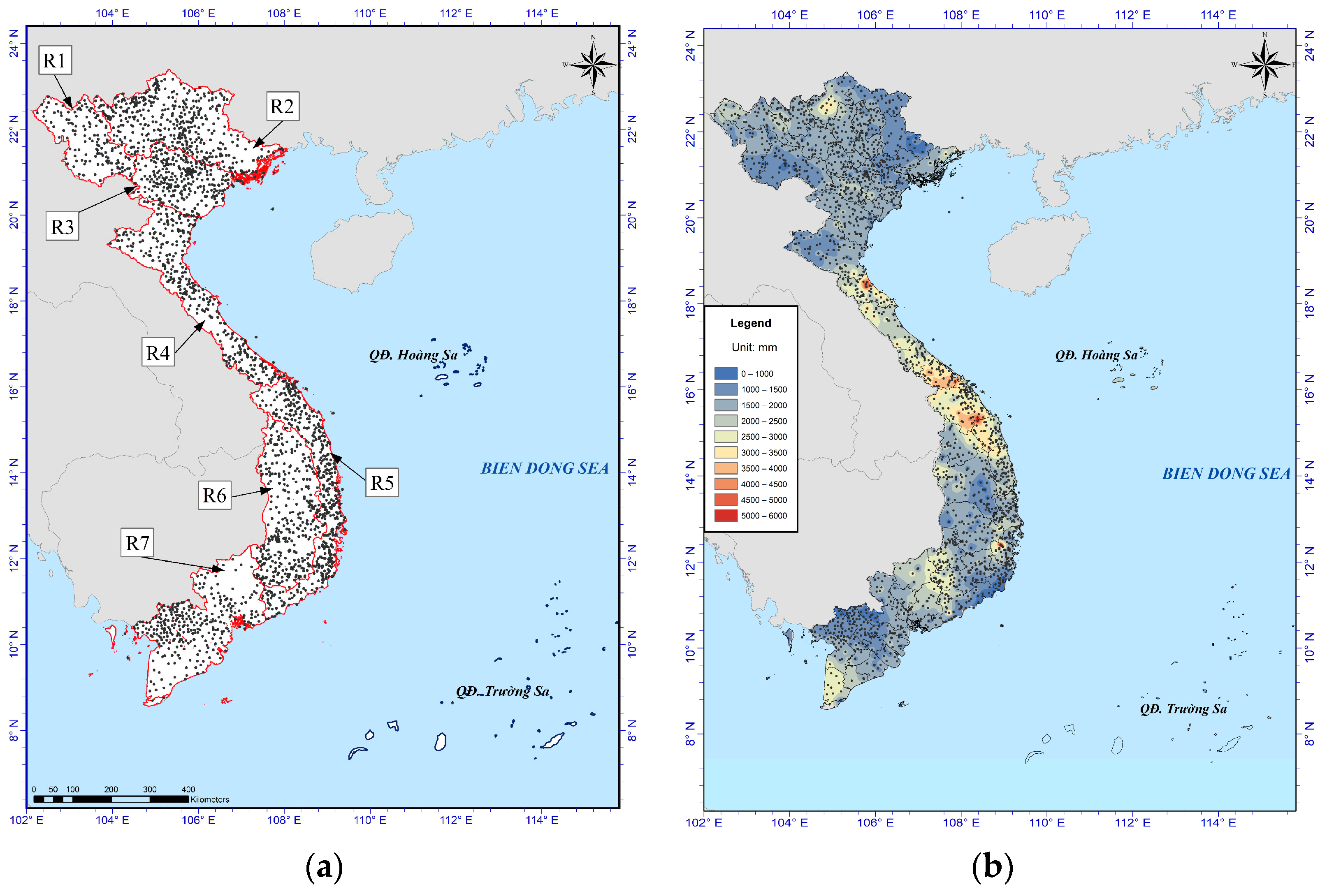
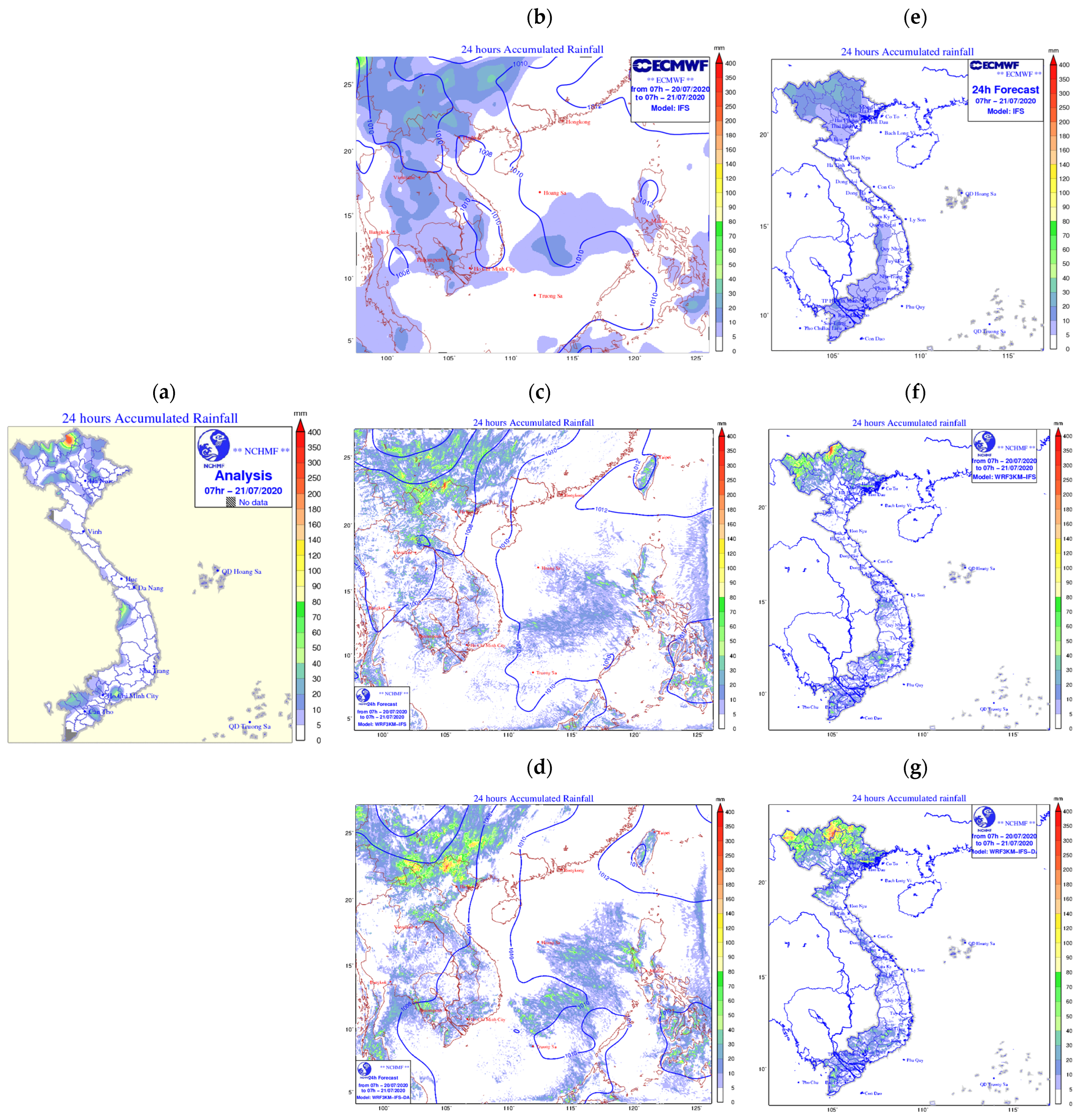
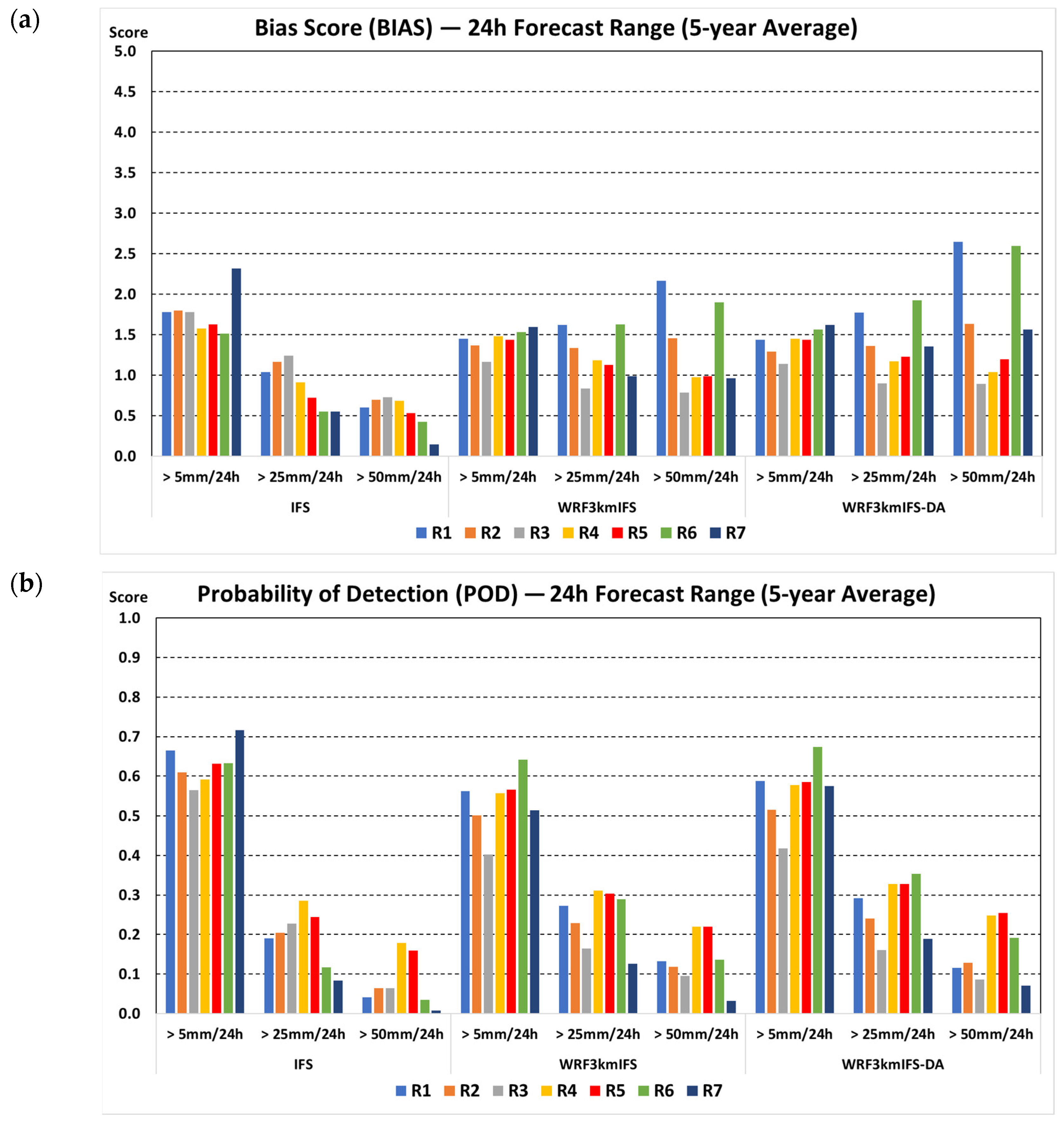
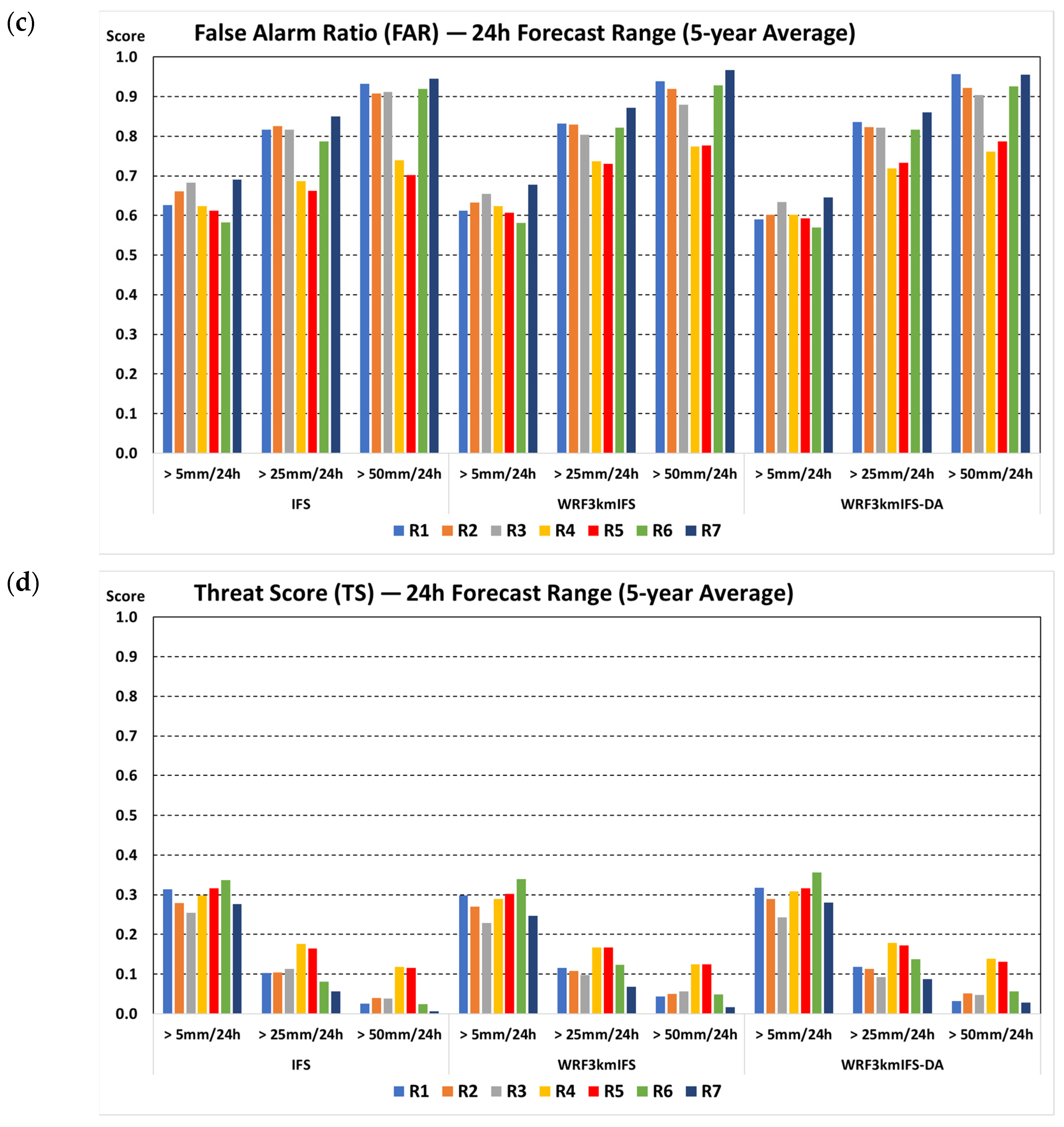

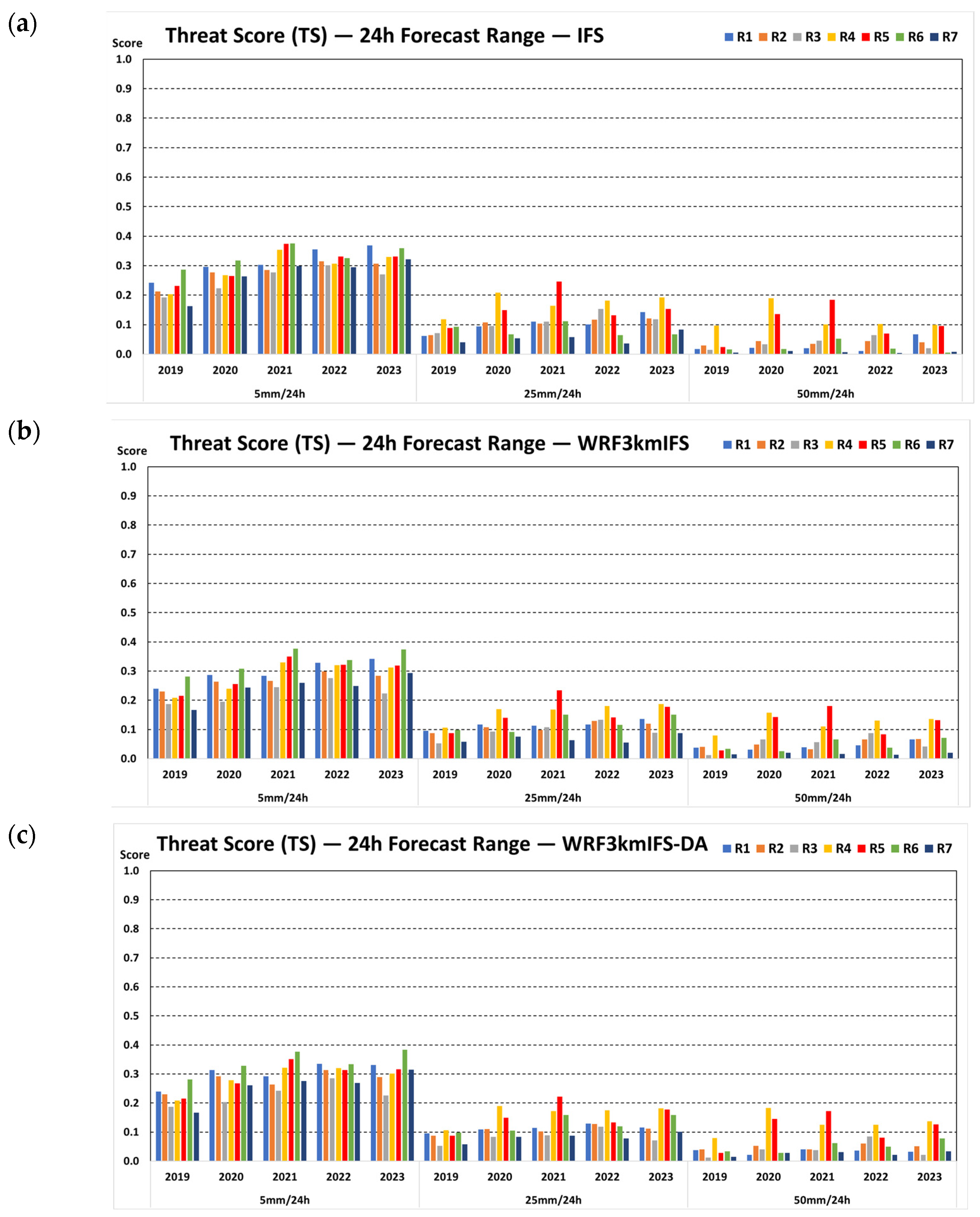
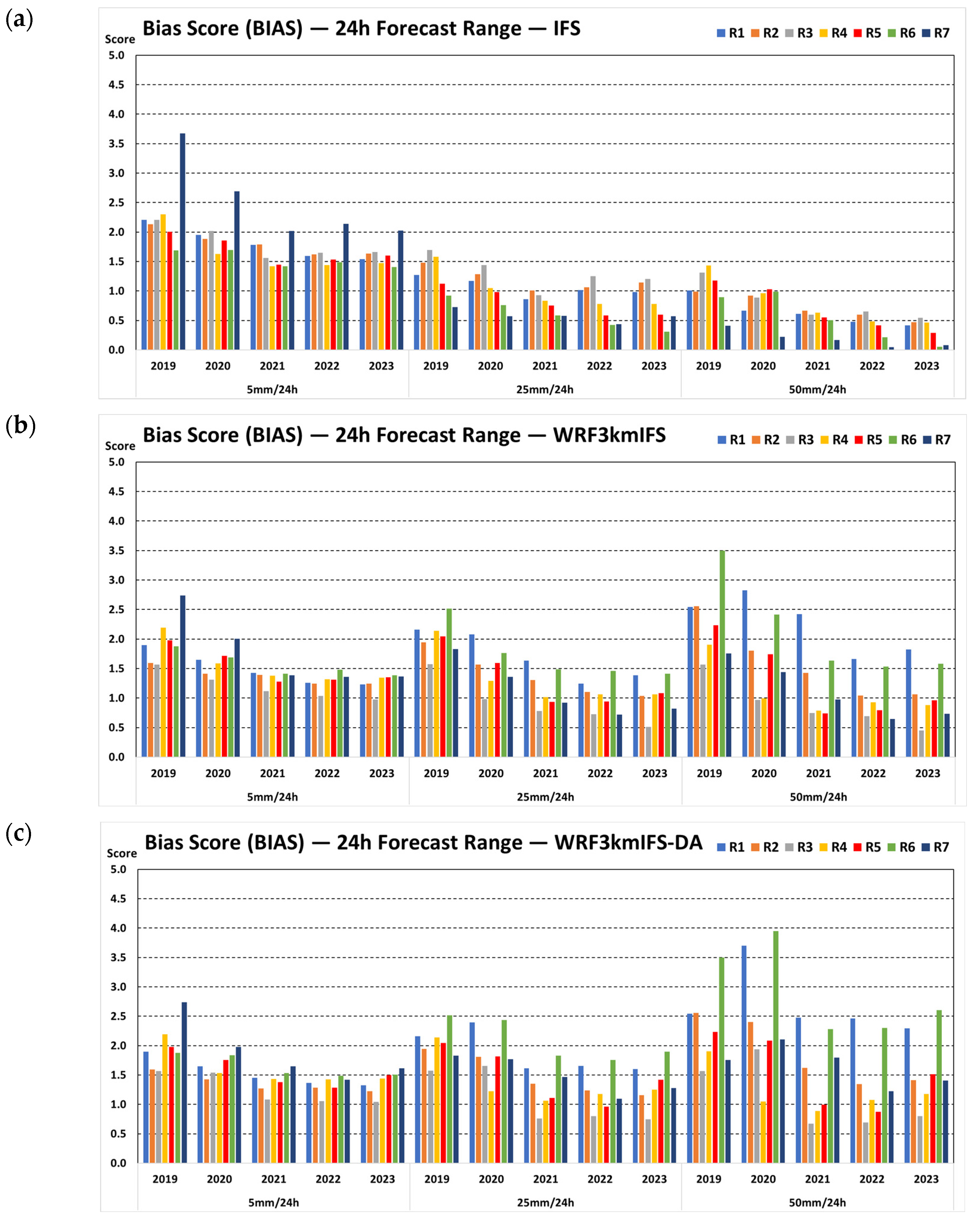
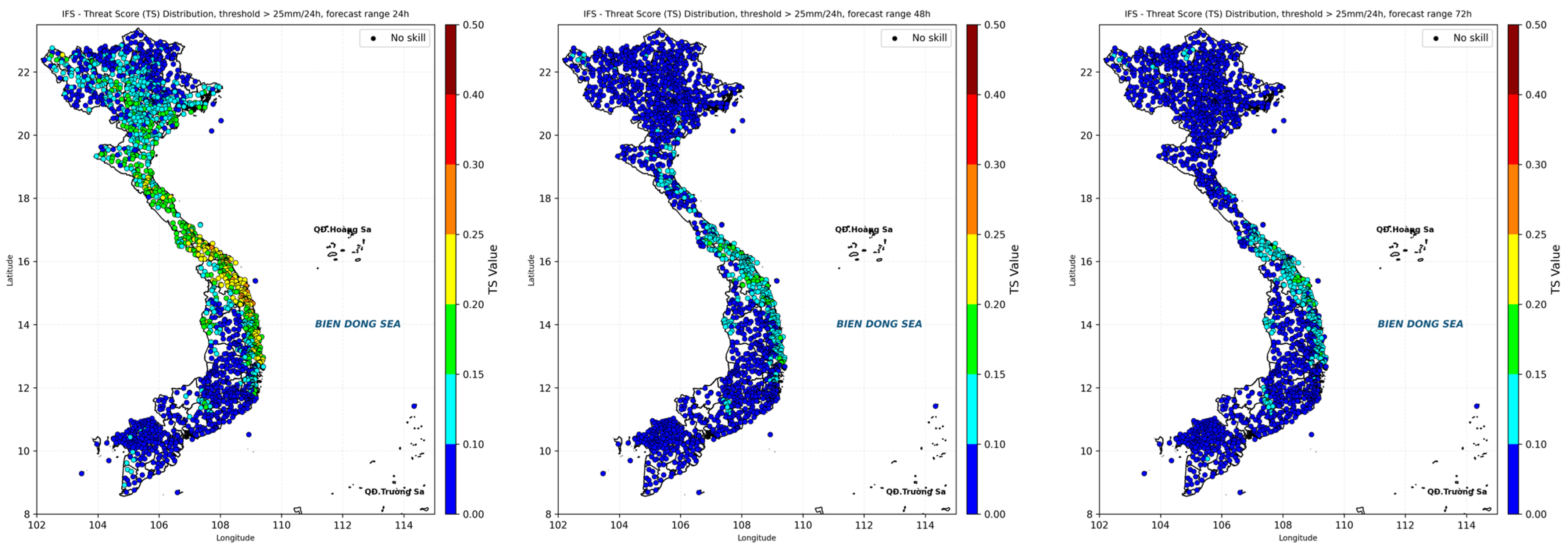
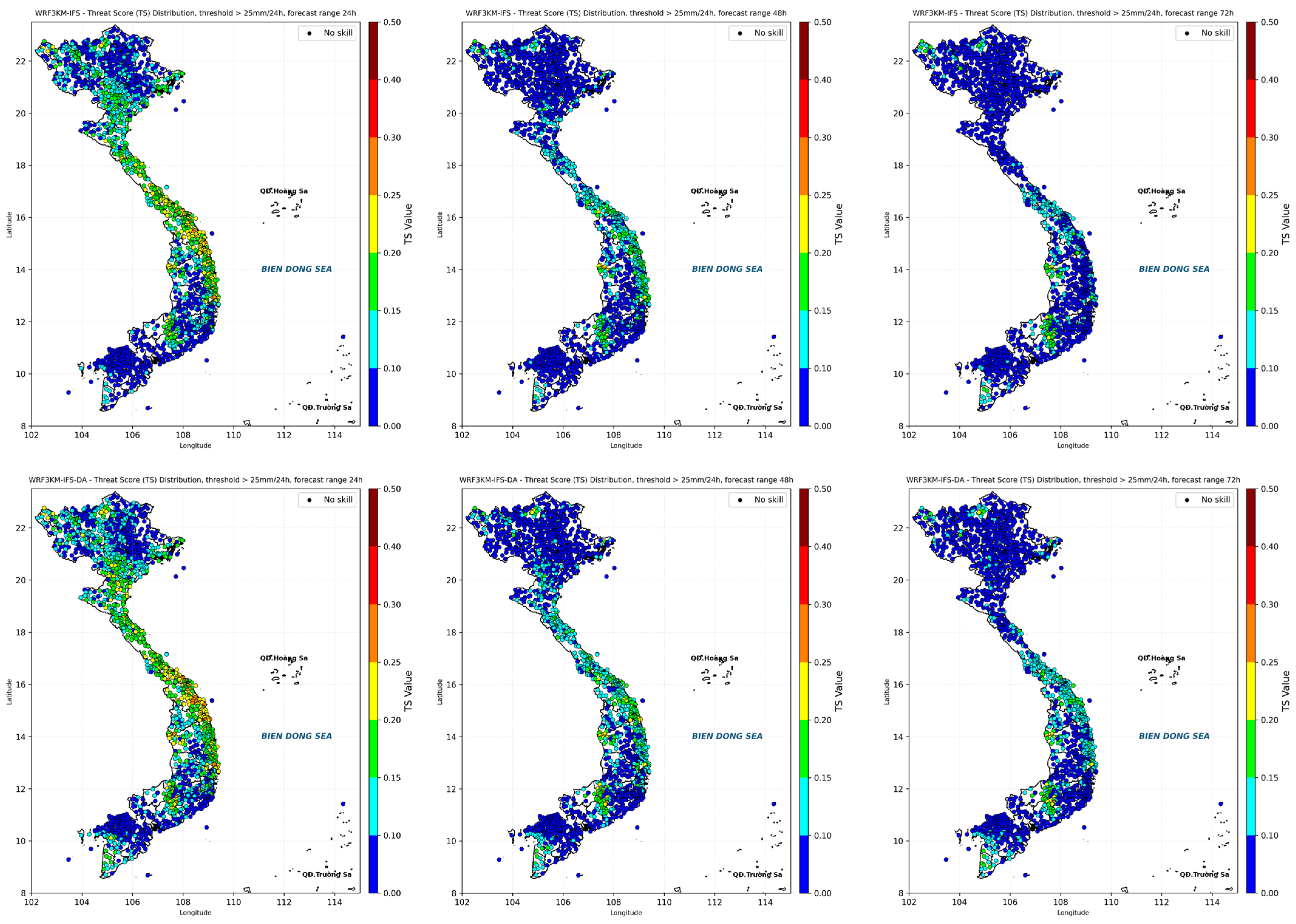
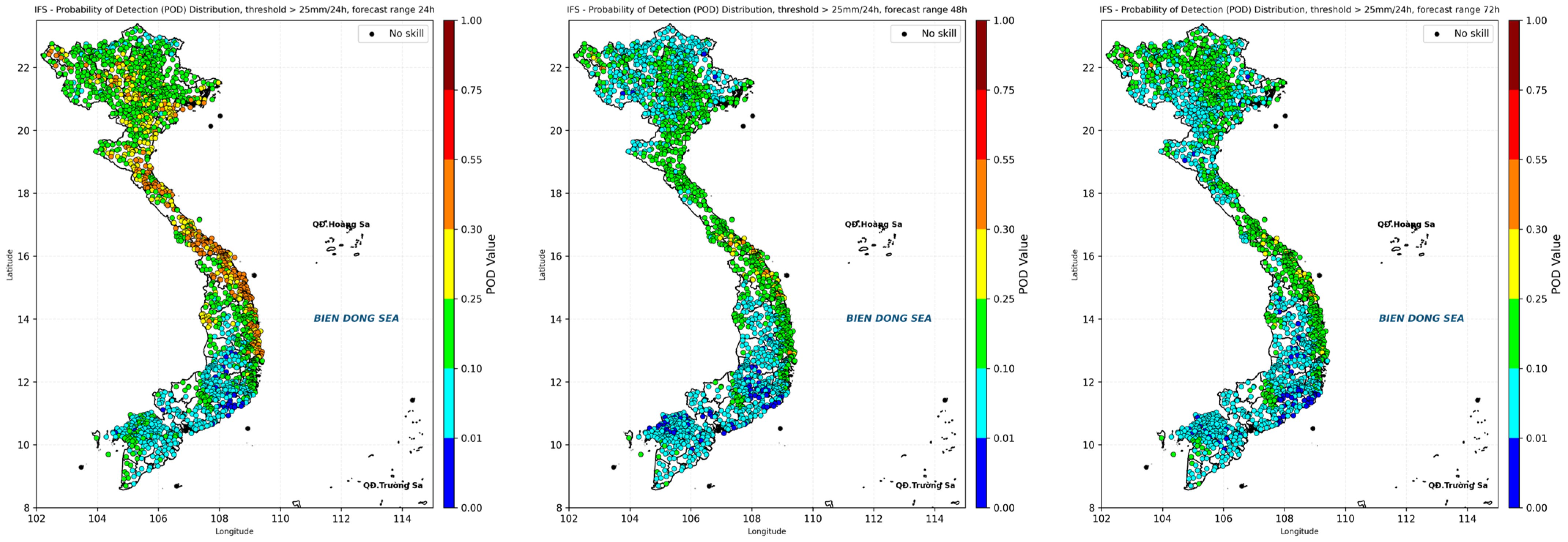
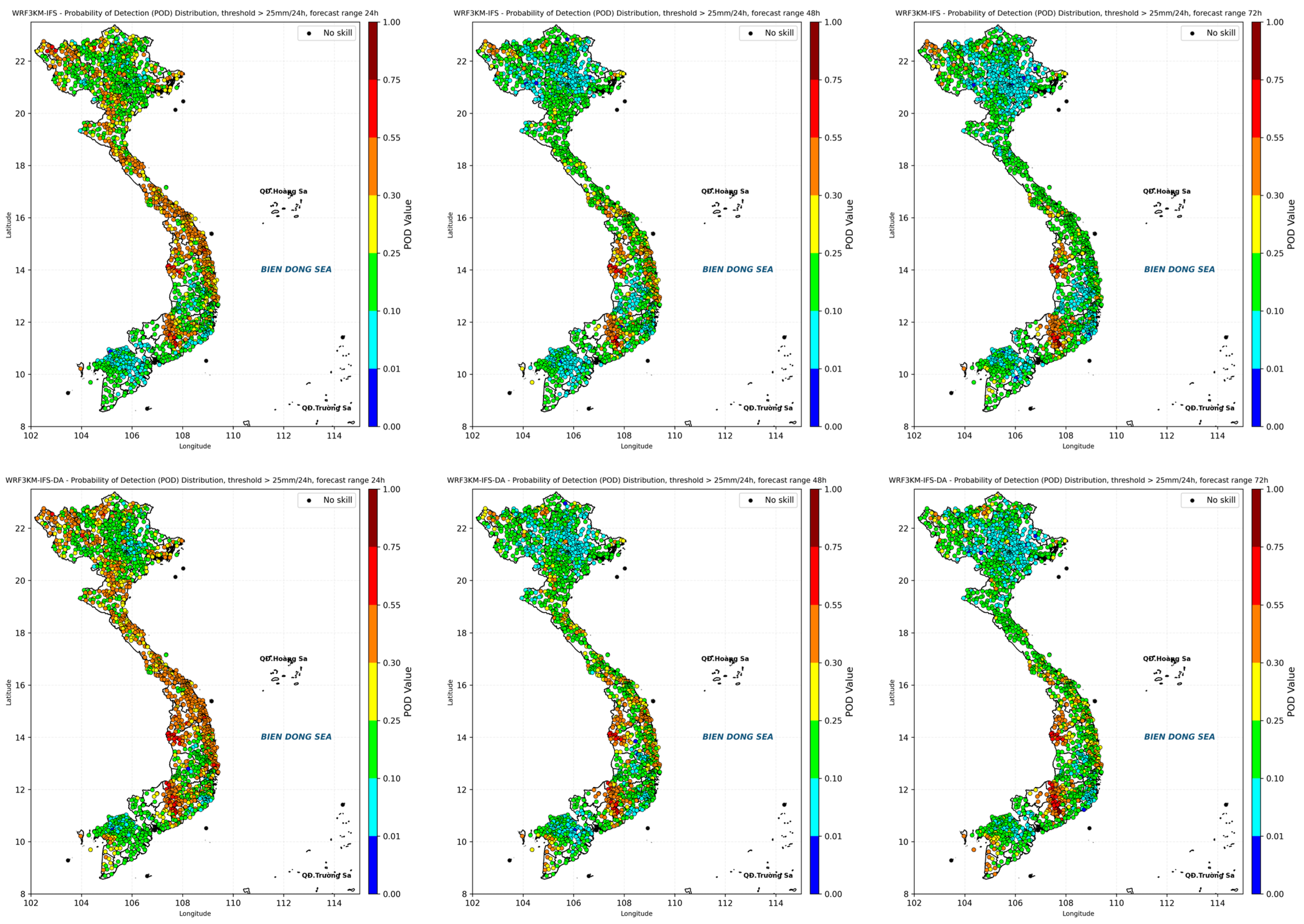
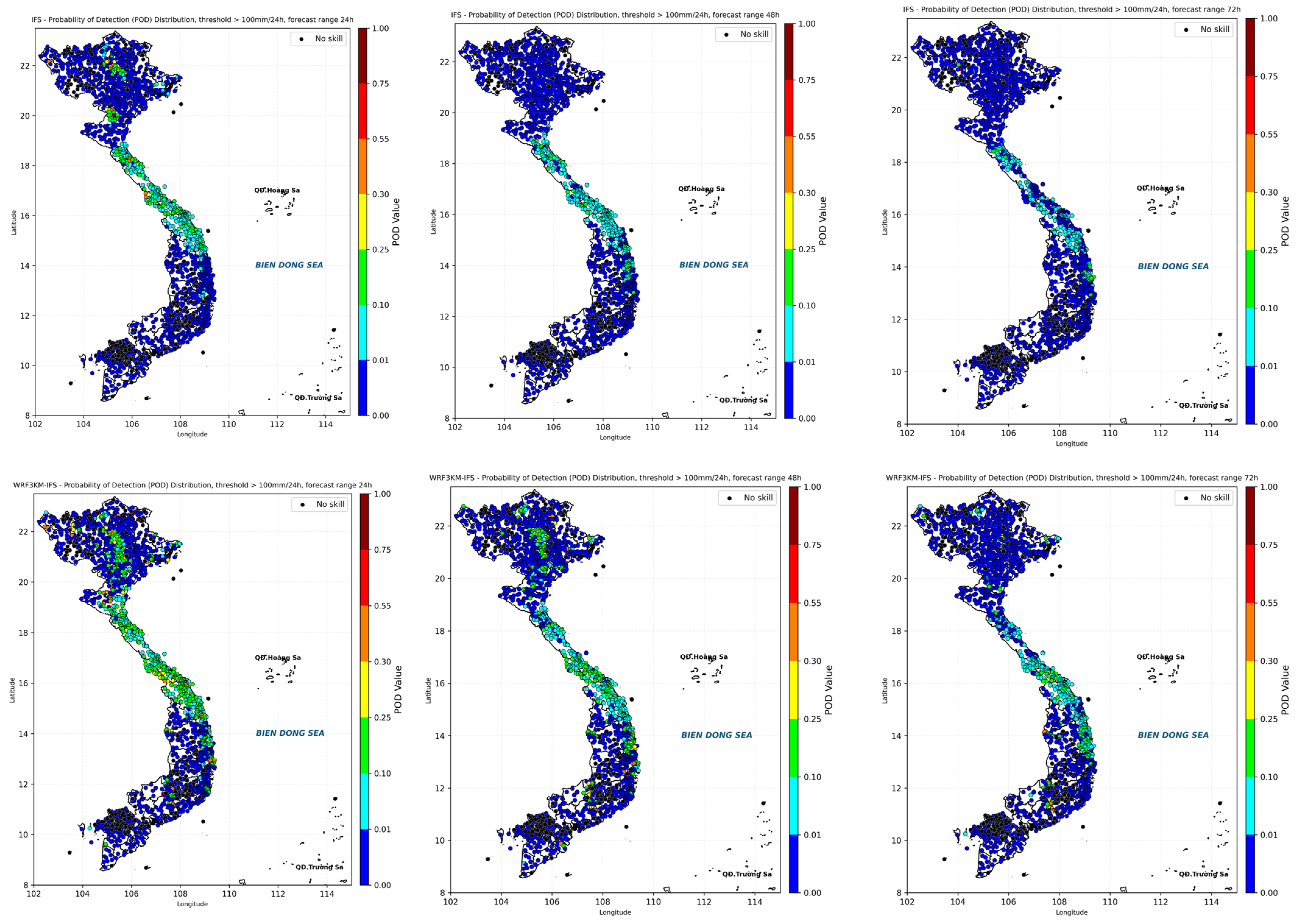
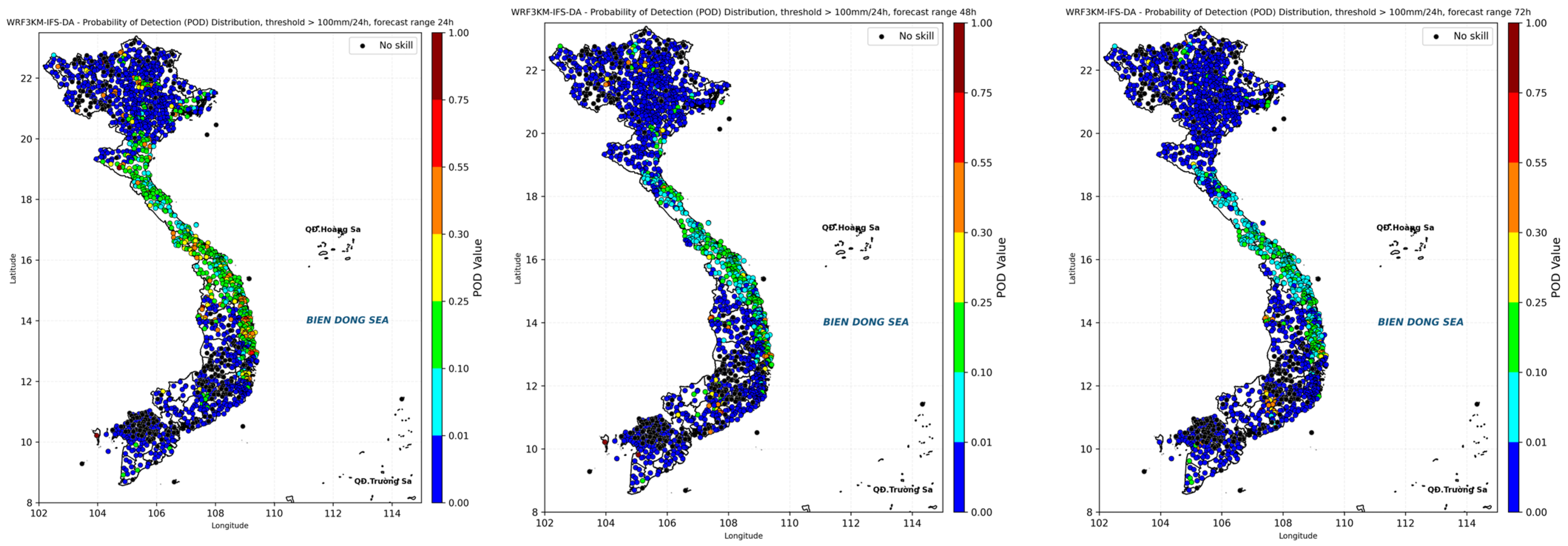
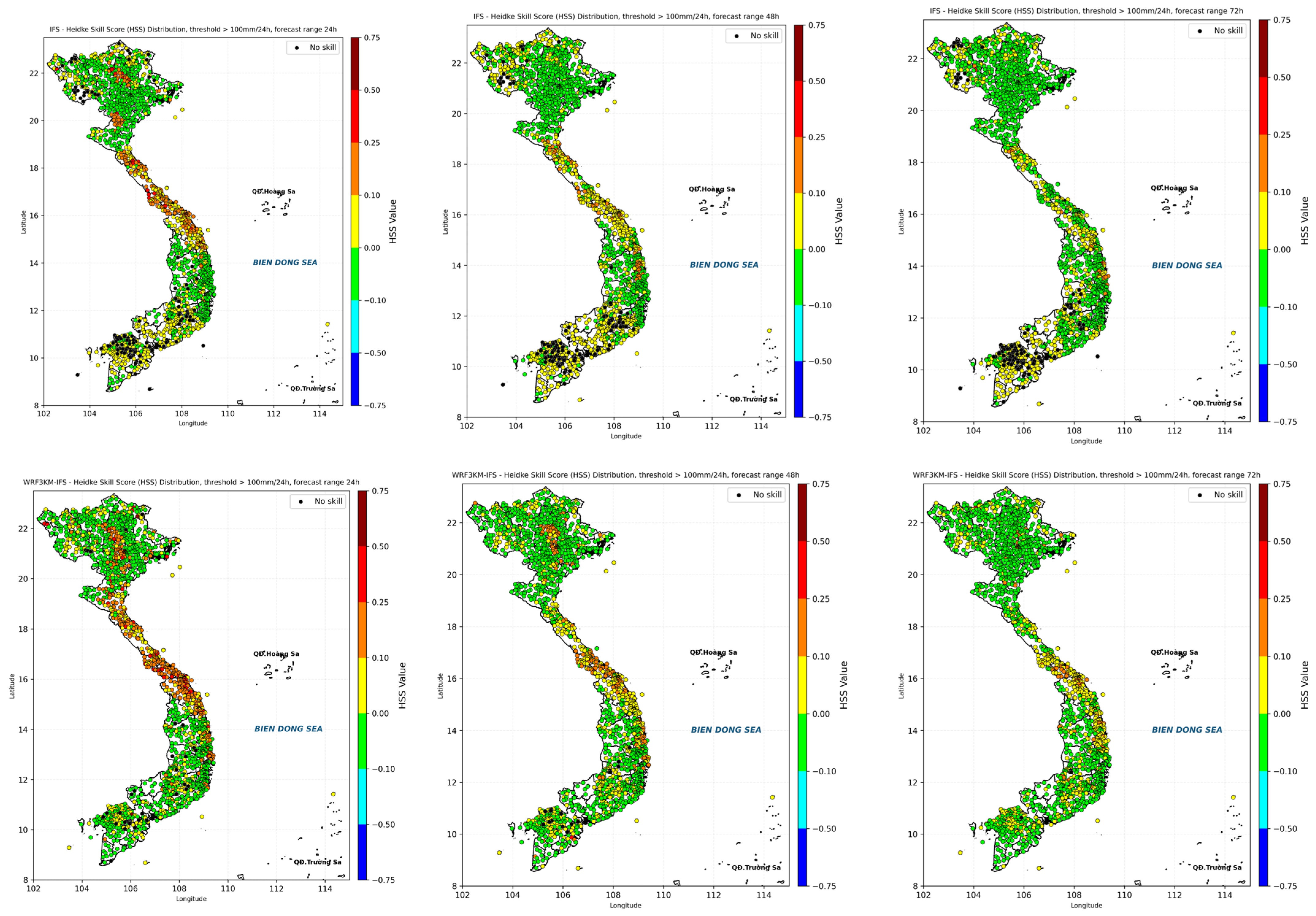

| Region | Annual Rainfall (MM) | Rainy Season | |
|---|---|---|---|
| R1 | the North West | 1200–2000 | from April to September |
| R2 | the North East | 1400–2000 | from April to November |
| R3 | the Red River Delta | 1400–1800 | from April to November |
| R4 | the North Central | 1400–2000 | from August to December |
| R5 | the South Central | 1200–2000 (northern) | from August to December |
| 1200–1600 (southern) | |||
| R6 | the Central Highlands | 1400–2000 | from May to October |
Disclaimer/Publisher’s Note: The statements, opinions and data contained in all publications are solely those of the individual author(s) and contributor(s) and not of MDPI and/or the editor(s). MDPI and/or the editor(s) disclaim responsibility for any injury to people or property resulting from any ideas, methods, instructions or products referred to in the content. |
© 2025 by the authors. Licensee MDPI, Basel, Switzerland. This article is an open access article distributed under the terms and conditions of the Creative Commons Attribution (CC BY) license (https://creativecommons.org/licenses/by/4.0/).
Share and Cite
Duc, T.A.; Khiem, M.V.; Hung, M.K.; Quan, D.D.; Trang, D.T.; Nam, H.G.; Hole, L.R.; Tien, D.D. Skill Validation of High-Impact Rainfall Forecasts over Vietnam Using the European Centre for Medium-Range Weather Forecasts (ECMWF) Integrated Forecasting System (IFS) and Dynamical Downscaling with the Weather Research and Forecasting Model. Atmosphere 2025, 16, 224. https://doi.org/10.3390/atmos16020224
Duc TA, Khiem MV, Hung MK, Quan DD, Trang DT, Nam HG, Hole LR, Tien DD. Skill Validation of High-Impact Rainfall Forecasts over Vietnam Using the European Centre for Medium-Range Weather Forecasts (ECMWF) Integrated Forecasting System (IFS) and Dynamical Downscaling with the Weather Research and Forecasting Model. Atmosphere. 2025; 16(2):224. https://doi.org/10.3390/atmos16020224
Chicago/Turabian StyleDuc, Tran Anh, Mai Van Khiem, Mai Khanh Hung, Dang Dinh Quan, Do Thuy Trang, Hoang Gia Nam, Lars R. Hole, and Du Duc Tien. 2025. "Skill Validation of High-Impact Rainfall Forecasts over Vietnam Using the European Centre for Medium-Range Weather Forecasts (ECMWF) Integrated Forecasting System (IFS) and Dynamical Downscaling with the Weather Research and Forecasting Model" Atmosphere 16, no. 2: 224. https://doi.org/10.3390/atmos16020224
APA StyleDuc, T. A., Khiem, M. V., Hung, M. K., Quan, D. D., Trang, D. T., Nam, H. G., Hole, L. R., & Tien, D. D. (2025). Skill Validation of High-Impact Rainfall Forecasts over Vietnam Using the European Centre for Medium-Range Weather Forecasts (ECMWF) Integrated Forecasting System (IFS) and Dynamical Downscaling with the Weather Research and Forecasting Model. Atmosphere, 16(2), 224. https://doi.org/10.3390/atmos16020224









